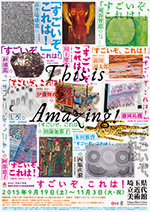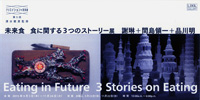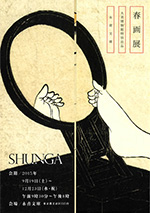 |
Picks is a monthly sampling of Japan's art scene, offering commentary by a variety of reviewers about exhibitions at museums and galleries in recent weeks, with an emphasis on contemporary art by young artists. |
 |
 |
 |
2 November 2015 |
 |
| 1 | 2 | |
 |
|
 |
 |
|
|
 |
 |
 |
 |
| This Is Amazing! |
| 19 September - 3 November 2015 |
The Museum of Modern Art, Saitama
(Saitama) |
 |
| Terumasa Ito has built some 800 "decoration trucks" out of paper over the past 30 years; Shiro gives form to her inability to communicate with others in paintings of young boys shunned or wounded by their peers; Moriya Kishaba covers sheets of paper with colored dots. There is indeed something amazing about the pursuit of meaning in meaninglessness as expressed through these "outsider" works. |
|
 |
|

|
 |
 |
 |
|
Eating in Future: 3 Stories on Eating |
|
3 September - 24 November 2015
|
LIXIL Gallery 2
(Tokyo) |
 |
Telling the titular three stories are Ryouichi Majima and Chelin, two artists who explore the relationship between food and art, and Akira Shinagawa, a specialist in "food consciousness theory" who joins them in a talk event. Majima offers such wacky creations as a huge fried-egg tabletop supported by four chicken legs and flanked by two chicken-shaped chairs. Chelin constructs towering skyscraper-like structures out of sugar and cream, portrayed here in a series of photographs that brilliantly juxtapose the two disparate scales of food and architecture. |
|
|
 |
 |
| Shunga |
|
19 September - 23 December 2015
|
|
Eisei-Bunko Museum
(Tokyo) |
 |
| This is the selfsame shunga (erotic ukiyo-e) exhibition that caused a sensation when it opened at the British Museum two years ago. Ironically, museums in Japan were loath to take this controversial project on, until the Eisei-Bunko Museum, whose board is chaired by former prime minister Morihiro Hosokawa, stepped forward. It is said that nearly every ukiyo-e artist of the Kamakura, Muromachi, and Edo periods (with the lone exception of the elusive Sharaku) dabbled in shunga, presumably in answer to insatiable demand. |
|
|
|
|
|
|
|

|
 |
 |
|
|
|
|
|
 |
|
|
|
|
|
|
|
 |
|
|
 |
|